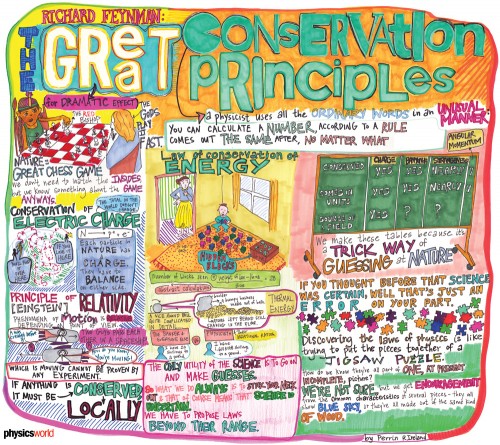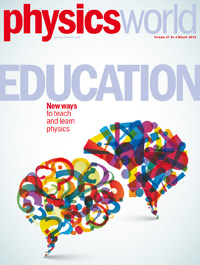
Richard Feynman lecture doodle by Perrin Ireland taken from the March 2014 issue of Physics World magazine.
By Matin Durrani and Louise Mayor
Commissioned by Physics World for the March 2014 education special issue, which examines new ways to teach and learn physics, this colourful image is based on a lecture by Richard Feynman called “The Great Conservation Principles”. It is one of seven Messenger Lectures that the great physicist gave at Cornell University in the US exactly 50 years ago, a video of which can be watched here or in the digital version of Physics World.
The drawing’s creator is professional “science doodler” Perrin Ireland – science communications specialist at the Natural Resources Defense Council in the US – who describes herself as “a learner who needs to visualize concepts in order to understand them”. For people like Ireland, thinking visually or in a story-like way helps them to recall facts and explanations, which can come in very useful when trying to learn something new.
So to find out what science doodling could bring to physics, we invited Ireland to watch Feynman’s 1964 lecture and create a drawing for us – the picture above being the result. Half a century after his lecture, Feynman remains an iconic figure in physics and although we’ll never know what he would have made of Ireland’s doodle, our bet is he would have been amused.
You can click on the image to see it in greater detail, and if you’re a member of the Institute of Physics (IOP), you can find out more about Ireland’s work and her motivations in an article in the digital version of the magazine or via the Physics World app, available from the App Store and Google Play.

If you’re not yet in the IOP, you can join as an IOPimember for just £15, €20 or $25 a year to get a full year’s access to Physics World both online and through the apps. We’ll also be making a free PDF download of the special education issue available to everyone later in March.
The issue is well worth checking out as it contains a heap of other great material on physics education. We examine the huge growth of “massive open online courses”, or MOOCs, in which universities make their lectures freely available in video form on the Internet, while physicist Philip Moriarty describes his experiences as one of the stars of the Sixty Symbols series of YouTube science videos. Both articles have specially made videos embedded in the digital magazine.
We also look at the importance of giving children computer-programming skills from an early age and there’s a great feature by BBC science presenter Fran Scott, who reveals her golden rules for engaging children with science. Physics-education experts Eugenia Etkina and Gorazd Planinšič, meanwhile, examine the implications for teachers of the fact that learning involves physical changes in the brain.
For the record, here’s a a run-down of highlights in the issue.
• Taking modern physics into schools – Having helped to introduce a new curriculum in Scottish schools that showcases the latest physics research, Martin Hendry describes the lessons learned in bringing cutting-edge physics into the classroom
• Feynman’s failings – They were never successful as a textbook. So why, a half-century after their publication, do so many physicists keep Richard Feynman’s three volumes within reach? Robert P Crease has a theory
• Computing in the classroom – Computer science is essential for modern physics, yet students come little prepared for it. That may soon change, says Jon Cartwright
• The power of YouTube – As one of the presenters of the hugely successful Sixty Symbols series of YouTube science videos, Philip Moriarty describes his experiences in front of the camera and how they have transformed his ideas about bringing physics to wider audiences
• Rules of engagement – Empowering children to look at the world around them with
curious, questioning eyes is the goal of Fran Scott, who describes the golden rules she follows to do just that
• Learning by doodling – Do your reams of written lecture notes ever really sink in?
Louise Mayor investigates how visual methods can help you process and remember information
• The MOOC point – Massive open online courses give students free access to some of the world’s top educators. James Dacey explores the benefits and drawbacks of these courses compared with those traditionally offered by universities
• Thinking like a scientist – Eugenia Etkina and Gorazd Planinšič describe how research into how people learn – plus the desire to help all students develop scientific “habits of mind” – is reshaping the way they teach physics
• We are bound by symmetry – Matthew R Francis reviews The Universe in the Rearview Mirror: How Hidden Symmetries Shape Reality by Dave Goldberg
• Plutopia forever – Kate Brown reviews The Girls of Atomic City by Denise Kierman
• Graduate careers special – Our bi-yearly special looks at the challenges of working abroad for physicists
• Navigating new cultures – Working overseas is a common career step for physics graduates, but moving countries can produce a culture shock. Sharon Ann Holgate explains how to manage the effects of cultural differences
• Making the right move – Your first steps into the world of work after graduation are an
adventure and working abroad can seem like an especially exciting way to begin. But is it
right for you? Marcia Malory investigates
• Lateral Thoughts: But it’s obvious – David Pye on strange conventions in physics
Enjoy the issue – and if you fancy trying a doodle of your own, we’d love to see your efforts, which you can e-mail to pwld@iop.org.
Trackback: Physics World brings Feynman lecture to life | Alin Velea
Trackback: Physics World reaches out with science doodles | FrogHeart
Trackback: Ceiba3D Studio | Our favourite pictures of 2014
Trackback: Blog - physicsworld.com
Trackback: Richard Feynman: The Great Conservation Principles | experrinment